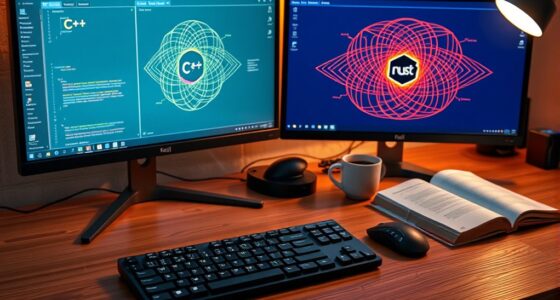GPU programming lets you harness the massive parallel power of GPUs to speed up tasks like image processing or machine learning. Frameworks like CUDA and OpenCL are your tools for writing code that runs on thousands of cores simultaneously. You’ll manage different types of memory and organize threads to maximize efficiency. As you explore these basics, you’ll find how to optimize performance and overcome common challenges—if you keep learning, you’ll master GPU programming more deeply.
Key Takeaways
- CUDA and OpenCL are frameworks that enable parallel programming on GPUs to accelerate computations.
- Understanding GPU memory hierarchy (global, shared, local) is essential for optimizing performance.
- Kernel functions execute parallel tasks across thousands of GPU cores, requiring effective workload management.
- Organizing threads and blocks, along with synchronization, ensures efficient and correct parallel execution.
- Best practices include minimizing data transfers, keeping data on GPU, and balancing workload for maximum efficiency.

If you’re new to GPU programming, you’re about to discover a powerful way to accelerate your applications. GPUs excel at handling tasks that can be broken down into smaller, independent operations, making parallel algorithms their bread and butter. When you start exploring GPU programming with CUDA or OpenCL, you’ll quickly see how these frameworks enable you to leverage thousands of cores simultaneously. This parallelism is key to boosting performance, especially in compute-heavy tasks like image processing, simulations, or machine learning. But to make the most of GPU power, you need to understand how to manage memory effectively. Unlike CPUs, GPUs have a distinct memory hierarchy that requires careful handling to avoid bottlenecks. You’ll want to familiarize yourself with different memory types, such as global, shared, and local memory, and understand how to optimize data transfers between them. Efficient memory management minimizes latency and guarantees your parallel algorithms run smoothly. Understanding water on water can also help you optimize data flow and memory usage in GPU programs by visualizing how data moves and interacts within the hardware. Getting started involves writing kernel functions—small programs that run on the GPU cores. These kernels perform the actual computations on data chunks in parallel. When you launch kernels, you specify how many threads and blocks you want, which directly influences how your workload is distributed across the GPU. Managing threads and blocks effectively allows you to maximize hardware utilization. You’ll learn to organize your data so that each thread processes a specific segment, reducing idle time and guaranteeing all cores are engaged. Proper memory management plays an essential role here: copying data from host (CPU) memory to device (GPU) memory is a key step. You need to minimize data transfers, since they can slow down your overall performance, by keeping data on the GPU as much as possible once loaded. As you develop your GPU programs, you’ll also encounter synchronization issues—making sure threads don’t interfere with each other and data consistency is maintained. CUDA and OpenCL provide synchronization primitives that help coordinate thread execution, preventing race conditions. Developing a clear understanding of how memory is allocated, transferred, and accessed across your parallel algorithms will save you a lot of debugging time and optimize your application’s speed. Remember, the foundation of successful GPU programming lies in balancing the workload, managing memory effectively, and designing your algorithms to take full advantage of the hardware’s parallel nature. With practice, you’ll find yourself creating highly efficient applications that leverage the massive computational power of GPUs, transforming your ideas into blazing-fast solutions.
Frequently Asked Questions
How Do I Choose Between CUDA and Opencl for My Project?
You should choose CUDA if your hardware is NVIDIA-based, as it offers optimized performance and extensive support. OpenCL is better if you need cross-platform compatibility across different hardware vendors like AMD and Intel. Consider programming language differences too: CUDA uses C++-like syntax, while OpenCL has a more flexible API. Your decision depends on your target hardware, project requirements, and preferred programming environment.
What Are Common Debugging Tools for GPU Programming?
When it comes to debugging your GPU code, you’ll find profiling tools and error diagnostics invaluable. Tools like NVIDIA Nsight and AMD’s CodeXL help you analyze performance bottlenecks and identify errors with ease. You can step through your code, monitor memory usage, and get detailed reports. These tools gently guide you through troubleshooting, making it easier to optimize your GPU applications and guarantee smooth, error-free performance.
How Does Memory Management Differ Between CUDA and Opencl?
You’ll find that CUDA manages memory allocation with functions like cudaMalloc and handles data transfer with cudaMemcpy, making it straightforward within NVIDIA’s ecosystem. OpenCL, however, requires you to explicitly allocate device memory using clCreateBuffer and manage data transfer with clEnqueueWriteBuffer and clEnqueueReadBuffer. This gives you more control but also demands more careful management of memory and data transfer operations across different devices.
Can I Run GPU Code on Integrated Graphics?
Yes, you can run GPU code on integrated graphics. For example, a student used their laptop’s integrated Intel GPU to accelerate a machine learning project, demonstrating GPU compatibility. Keep in mind, integrated graphics like Intel’s or AMD’s Radeon Vega are less powerful than dedicated GPUs, so performance might be limited. Nonetheless, many programming frameworks support integrated graphics, making it a viable option for learning or less demanding tasks.
What Are Best Practices for Optimizing GPU Kernel Performance?
To optimize your GPU kernel performance, focus on efficient kernel optimization techniques like minimizing memory access latency and maximizing parallel execution. Use shared memory wisely, coalesce global memory accesses, and avoid divergent threads. Profile your code regularly, identify bottlenecks, and tailor your kernel design accordingly. By fine-tuning memory access patterns and ensuring your kernels run smoothly in parallel, you’ll markedly enhance overall performance and achieve better computational throughput.
Conclusion
As you gently step into the world of GPU programming, you’ll find yourself weaving through a vibrant tapestry of parallel processes and shimmering data streams. With patience, you’ll nurture your skills, guiding your code like a delicate brushstroke on a vast canvas. Over time, this journey becomes a dance of light and shadow, revealing the true beauty of accelerated computing. Embrace the learning curve, and you’ll soon craft masterpieces that brighten the landscape of technology.








